Unique technical characteristics, as well as very good aesthetic properties, have recently attracted more and more attention to this type of roof, such as a reed roof.
This technology has received the greatest distribution recently in the countries of the Western world; it can very often be found in the USA.
Content
DIY reed roof
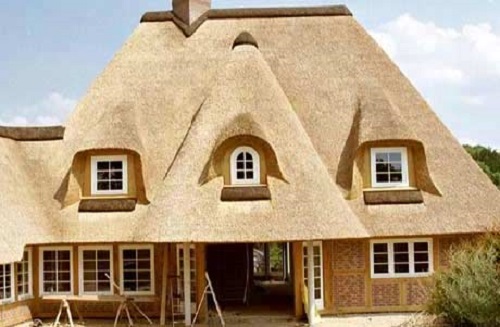
Probably, since the time of the primitive communal system, people when erecting roofs used the branches and leaves of various plants to protect their homes from adverse weather conditions. Therefore, it is not surprising that until now the reed roof remains very popular and is, perhaps, one of the oldest.
We can say that at present this method of covering the roof is receiving a rebirth. Why it happens? People strive to surround themselves with natural materials, environmentally friendly products and safe things. And fully satisfies such desires - a roof made from reeds with his own hands created.
The reed roof is, of course, not the most common type of roofing material. This material belongs to the elite types of roofing. Protecting the house from adverse weather effects, the roof of the reeds is nothing more than a way of self-expression of the owner and his household.
The main material for the reed roof
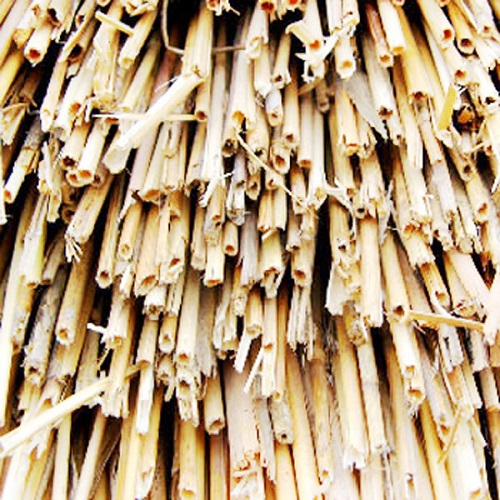
To create such a roof, ordinary reed stalks are used. You might think that since this is reed, the material should be light enough. In fact, this is far from the case, only one square meter of this coating weighs about 40 kilograms. And this is only if the reed roof is dry enough, otherwise, with a wet roof, the weight of such a square increases by another 10 kilograms.
Such roofing material is installed on fairly simple forms of roofs, where the angle of inclination should not be higher than 45 degrees.
As a rule, just reeds to cover the roof are not enough, so very often add additional elements that consist of tiles, and sometimes a tree is added to the overall design of the roof. Roof tiles and wood are used to protect the ridge of the roof.
Do-it-yourself reed roof, main advantages
Of course, it is necessary to say about the advantages of this material, but they certainly are. These are such as:
- 100% attractiveness and aesthetics;
- the coating is environmentally friendly and natural;
- good abilities of this type of roof to keep the temperature in the house unchanged;
- no need to install ventilation in the attic.
At the same time, the reed roof allows you to fully comply with generally accepted standards of thermal insulation, because if the roof is covered with such a material with a thickness of 30 centimeters, then all thermal insulation parameters will be completely satisfied.
With proper installation, the roof of the reeds is 100% good at protecting the house from various atmospheric influences, such as strong gusts of wind or numerous rainfall.
As for the service life, the manufacturers claim that such a reed roof can stand for decades. Although, given the fragility of this material, this statement raises great doubts.
High fire resistance is also inherent in such a roof, of course, if you pre-treat the material with special flame retardants.
Some tricks are also used to protect your home from fire. Install higher pipes through which smoke should escape. In this case, the spark, if it flies out, will go out very quickly, without having to touch the roof.
Technology features during the installation of this type of roof
Thanks to very great competition, construction companies are always ready to offer a wide variety of different types of reeds that can be used to cover the roof.
In order to make the reed roof comfortable for the owner, you can use the technologies that had already been tested hundreds of years ago.
Consider the main ones:
- Dutch technology;
- Danish
- English
- American
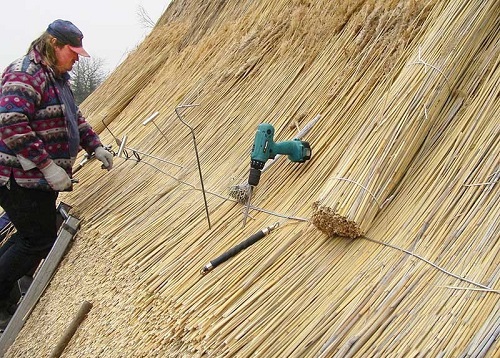
Whatever laying method you used during installation, all reed bundles should be lapped. To fix them most firmly, you can use a wire, but it must be stainless steel. In the middle of the entire beam, a clamp is installed.
The differences in the above technologies are that the length of the stems when laying in each country is different.
For example, laying according to Dutch technology involves the use of bundles of reeds long from 1 meter to 2. The thickness of the stems should also be a certain size (from 0.2 to 6 centimeters).
Danish technology uses stems with a thickness of 0.4 centimeters and a length of at least 1 meter.
If the roof is more uniform in composition and lies quite tight, then it will look most attractive. And the practical value of this product will grow significantly.
Depending on the tamping of the roofing material, its reliability also increases or decreases, as well as such a parameter as friability. For example, the reed roof, which was made according to the method of Polish technology, will be much looser than, for example, the reed roof made using English technology.
In other words, by and large, all laying technologies are fundamentally very similar to each other. Their only difference is the length and width of the reed material, as well as its coating on the roof ridge.
There are also other coating options - open and closed reed roofs. If you take the first option, then the tufts of material must be put on the crate so that the inner surface of the coating would be the ceiling for the room that will be under the roof.
This option can often be seen in the design of some trendy restaurants as a decorative element. However, of course, some inconveniences cannot be avoided. For example, fluff from reeds can get on your face, and the whole structure will require a lot of installation effort.
If you cover the roof like a closed roof, then the installation will be much easier, since the roofing material itself will be laid on solid wooden sheets of wood, which can also play the role of a waterproofing material. Well, of course, the installation of the second type can be done much faster.
Reed roof Dutch technology
When constructing private houses, it is best to use a type of roof such as a closed reed roof. In this case, most often you can meet, it is the Dutch roofing system. You can read more about this later.
At first there is a solid base, and only then sheaves are attached to this solid base with the help of self-tapping screws or screws. As a basis, most often use sheets that consist of plywood in several layers (particleboard or fiberboard).
A prerequisite for proper installation is that the base sheets must be absolutely even, dry, and also meet all the tightness parameters.If during the construction of the roof, windows or other elements are planned in the project, then they must be covered with insulating material in the first place and increased attention should be paid to these structures.
Important points for installation
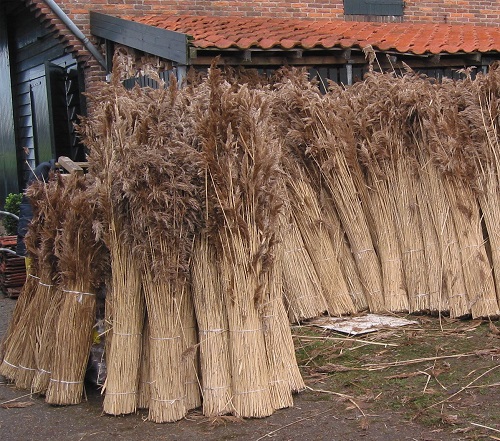
Particular attention must be paid to the quality of reed material. After all, it will depend on how long such a reed roof lasts.
The work should use exclusively the stalk of freshwater reeds, but it should be without leaves. The reed stalks should not look charred or moldy and should not be mixed with other plants.
In those places where the reed greatly extends beyond the borders at the base of the roof, it must be compressed. But the compression should be carried out in such a way that no gaps remain.
For compression to be most successful, you need to use wire clamps that contain a zinc coating. The first clamps are made at a length of 20 centimeters from the pressure panel. The second is already being made a little closer, in the region of 12 centimeters, all the rest are carried out at a distance of about 30 centimeters from each other.
For the reliability of the entire roof, the beams must be very well fixed. In those places where there is a corner beam, you need to use the method of fastening with a thin wire.
If the distance from the pressure plate to the ridge part of the roof is less than 7 meters and the angle of inclination of the roof from the reeds will be approximately 40 degrees, then the thickness of the roofing material should be no less than 25 centimeters at the very bottom of the roof, and about about 22 centimeters in place of the ridge.
By the appearance of the roof, you can immediately see how correct the installation of the roof was. Roofing material must lie flat. But you should not pay special attention to the difference in color and shape of the leaves themselves, because the reed is a natural material, and therefore it can have different color shades.
The difference in color can be very clearly seen on the newly assembled roofs. But this in no way can be considered a defect. Over time, such a contrast will practically not be noticeable.
What you need to consider in order to properly align the reed roof bunches
For the permanent fastening of sheaves, various techniques can be used.
Here are just the most used:
- The first method is wire firmware. It is most suitable for those roof options that are open type. The fastening work can be safely carried out together. One works directly on the surface of the roof, while the other helps indoors.
- For the fastest fastening, it is better to prepare screws with wire loops in advance.
- It is possible to flash with nails, this option is almost identical to the previous one, the only difference is that not nails are used with screws.
- Another common method is flashing firmware. In this embodiment, the wire, in fact, is a constriction. With it, pieces of reeds are attached to the base of the roof.
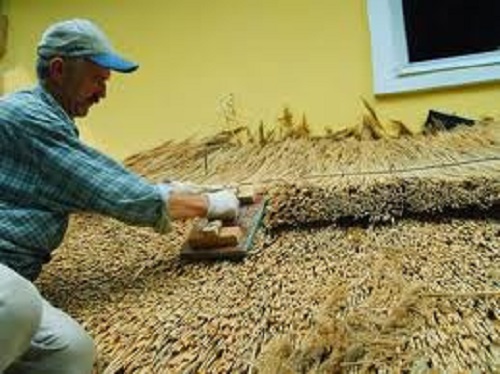
In order to give an even greater density to the layer of reeds, when leveling it, tamping is quite often used, it is made using a shovel-bit. This tool helps to level the reed flooring very well.
The final stage after the entire roofing and its leveling is the final trimming and giving the finished look to the roof. Here, of course, a lot depends on the wishes of the client himself, who ordered this type of roof. You can make a cut so that everything is neat, but you can leave some kind of “creative mess”, that's who you like.

All layers of reeds should be very firmly fixed, only the topmost layer can be left loose, otherwise the roof will not perform well the functions of protection against adverse weather conditions.
The reed roof is an excellent choice in order to decorate the look of a private house or to add originality and originality to your outbuildings. But it is worth remembering that the installation of such a roof is rather laborious, and, of course, it requires considerable professionalism and experience in the construction of such roofs.

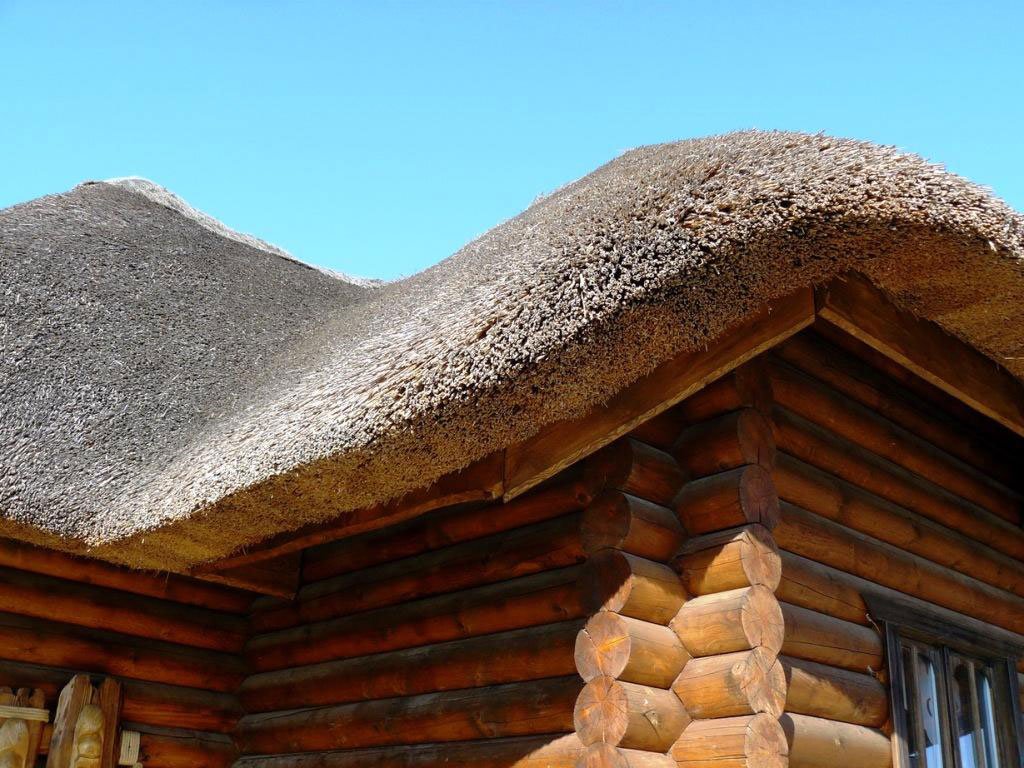
Alas, no comments yet. Be the first!